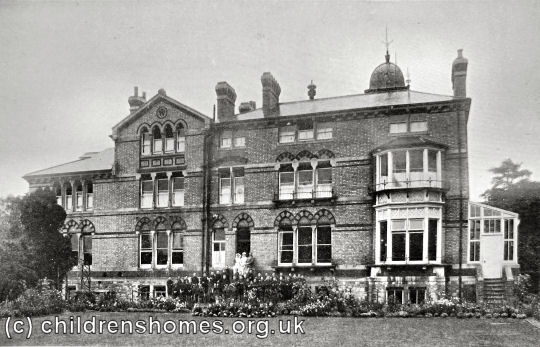St Augustine's Home for Boys, Sevenoaks, Kent
St Augustine's Home for Boys was opened by the Waifs and Strays Society in 1921 in the premises of a former school on St John's Road, Sevenoaks, Kent. It was designated at the time as the 'Peace Thank-Offering Home' marking the end of the First World War. The home was dedicated on November 22nd by the Bishop if Rochester and given the name of St Augustine who 'had brought the Gospel of Peace to the shores of Kent.' There may also be a link between the home and the St Augustine's Home for Boys at Clewer in Berkshire which closed in 1921.

St Augustine's Home for Boys, Sevenoaks, c.1923. © Peter Higginbotham
St Augustine's was one of the Society's largest homes, housing 42 boys aged from 7 to 15. The building was divided into four separate living quarters and dormitories which were named Philip Sydney, Francis Drake, George Herbert, and David Livingstone, along the lines of school 'houses'. The boys could be awarded marks for good work or behaviour, with the sections competing to score the highest tally.

St Augustine's Home for Boys, Sevenoaks, c.1926. © Peter Higginbotham
By 1932, the home had become a 'Special Training Home' for older boys who wished to become military bandsmen. The home's band proved very popular and often performed at local events.
In 1936, in the wake of the Children and Young Persons Act of 1933, the Home Office requested that St Augustine's become an Approved School. Although the change took place, the home was closed in June 1938 and the property was disposed of.
Records
Note: many repositories impose a closure period of up to 100 years for records identifying individuals. Before travelling a long distance, always check that the records you want to consult will be available.
- Index of the Society's first 30,000 children's case files ordered by surname.
- Index of the Society's first 30,000 children's case files ordered by date of birth.
- The Children's Society Records and Archive Centre is at Unit 25, Springfield House, 5 Tyssen Street, London E8 2LZ (email: archives@childrenssociety.org.uk). Files for children admitted to its homes after September 1926 were microfilmed in the 1980s and the originals destroyed. Some post-1926 files had already been damaged or destroyed during a flood. The Society's Post-Adoption and Care Service provides access to records, information, advice, birth record counselling, tracing and intermediary service for people who were in care or adopted through the Society.
- The Society has produced detailed catalogues of its records relating to disabled children, and of records relating to the Children's Union (a fundraising body mostly supported from the contributions of children).
Bibliography
- Bowder, Bill Children First: a photo-history of England's children in need (1980, Mowbray)
- Church of England Waifs and Strays' Society [Rudolfe, Edward de Montjoie] The First Forty Years: a chronicle of the Church of England Waifs and Strays' Society 1881-1920 (1922, Church of England Waifs and Strays' Society / S.P.C.K.)
- Higginbotham, Peter Children's Homes: A History of Institutional Care for Britain's Young (2017, Pen & Sword)
- Morris, Lester The Violets Are Mine: Tales of an Unwanted Orphan (2011, Xlibris Corporation) — memoir of a boy growing up in several of the Society's homes (Princes Risborough, Ashdon, Hunstanton, Leicester) in the 1940s and 50s.
- Rudolf, Mildred de Montjoie Everybody's Children: the story of the Church of England Children's Society 1921-1948 (1950, OUP)
- Stroud, John Thirteen Penny Stamps: the story of the Church of England Children's Society (Waifs and Strays) from 1881 to the 1970s (1971, Hodder and Stoughton)
Links
- Hidden Lives Revealed — the story of the children who were in the care of The Children's Society in late Victorian and early 20th Century Britain.
- The Children's Society
Except where indicated, this page () © Peter Higginbotham. Contents may not be reproduced without permission.


